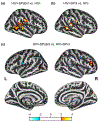The Resting State Central Auditory Network: a Potential Marker of HIV-Related Central Nervous System Alterations
- PMID: 35044995
- PMCID: PMC9232992
- DOI: 10.1097/AUD.0000000000001186
The Resting State Central Auditory Network: a Potential Marker of HIV-Related Central Nervous System Alterations
Abstract
Objective: HIV positive (HIV+) individuals with otherwise normal hearing ability show central auditory processing deficits as evidenced by worse performance in speech-in-noise perception compared with HIV negative (HIV-) controls. HIV infection and treatment are also associated with lower neurocognitive screening test scores, suggesting underlying central nervous system damage. To determine how central auditory processing deficits in HIV+ individuals relate to brain alterations in the cortex involved with auditory processing, we compared auditory network (AN) functional connectivity between HIV+ adults with or without speech-in-noise perception difficulties and age-matched HIV- controls using resting-state fMRI.
Design: Based on the speech recognition threshold of the hearing-in-noise test, twenty-seven HIV+ individuals were divided into a group with speech-in-noise perception abnormalities (HIV+SPabnl, 38.2 ± 6.8 years; 11 males and 2 females) and one without (HIV+SPnl 34.4 ± 8.8 years; 14 males). An HIV- group with normal speech-in-noise perception (HIV-, 31.3 ± 5.2 years; 9 males and 3 females) was also enrolled. All of these younger and middle-aged adults had normal peripheral hearing determined by audiometry. Participants were studied using resting-state fMRI. Independent component analysis was applied to identify the AN. Group differences in the AN were identified using statistical parametric mapping.
Results: Both HIV+ groups had increased functional connectivity (FC) in parts of the AN including the superior temporal gyrus, middle temporal gyrus, supramarginal gyrus, and Rolandic operculum compared to the HIV- group. Compared with the HIV+SPnl group, the HIV+SPabnl group showed greater FC in parts of the AN including the middle frontal and inferior frontal gyri.
Conclusions: The classical auditory areas in the temporal lobe are affected by HIV regardless of speech perception ability. Increased temporal FC in HIV+ individuals might reflect functional compensation to achieve normal primary auditory perception. Furthermore, increased frontal FC in the HIV+SPabnl group compared with the HIV+SPnl group suggest that speech-in-noise perception difficulties in HIV-infected adults also affect areas involved in higher-level cognition, providing imaging evidence consistent with the hypothesis that HIV-related neurocognitive deficits can include central auditory processing deficits.
Copyright © 2021 Wolters Kluwer Health, Inc. All rights reserved.
Conflict of interest statement
Declaration of Interests
The authors have no financial or personal relationships that could inappropriately bias their work.
Figures


References
-
- Acheson DJ, Hagoort P (2013). Stimulating the brain’s language network: Syntactic ambiguity resolution after TMS to the inferior frontal gyrus and middle temporal gyrus. J Cogn Neurosci, 25, 1664–1677. - PubMed
-
- Ashburner J, Friston KJ (2005). Unified segmentation. Neuroimage, 26, 839–851. - PubMed
-
- Bell AJ, Sejnowski TJ (1995). An information-maximization approach to blind separation and blind deconvolution. Neural Comput, 7, 1129–1159. - PubMed
MeSH terms
Grants and funding
LinkOut - more resources
Full Text Sources
Medical

